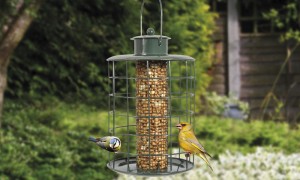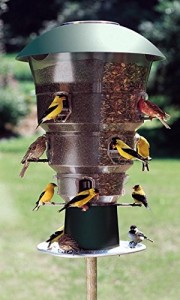Week 35 – 12 March 2017:
To Feed, Or Not To Feed
Do you provide food for wild birds in your yard? If so, then you are not alone. It seems that nearly half of all householders in Great Britain feed birds, and as many as 53 million households in the United States do the same. Sunflower seeds, nyger, millet, wheat, fat, artificial nectar… it all adds up to an industry worth hundreds of millions of dollars each year. The joy that results when our feathered friends arrive in our yards to feast cannot be overstated. Birds feeders provide opportunities to develop a greater sense of empathy with wild birds. Similarly, there is little doubt that feeding birds in the non-breeding season adds substantially to their over-winter survival.
Despite all of these positive outcomes, is it possible that we are doing more harm than good by feeding wild birds during the breeding season? Could it be that bird feeders create a situation where predation of eggs and chicks increases?
Hugh Hanmer and his colleagues at the University of Reading in the UK addressed this important issue. Rather than struggling with the logistical and ethical challenges associated with predators and real bird nests, they constructed artificial nests from wire mesh, and lined them with dried grass. These were meant to mimic the nests of Eurasian Blackbirds, and were attached to trees at an appropriate height. Each nest received a pair of Japanese Quail eggs. Feeders were installed nearby, either empty, filled with peanuts, or filled with peanuts but fitted with a guard to exclude grey squirrels and large birds such as Eurasian Magpies. Each nest was monitored by a camera that was equipped with a motion-activated trigger.
Of 102 experimental nests, the contents of seventy-four were preyed upon. Those nests that were located close to filled feeders were substantially more likely to have been visited by magpies, squirrels or European Jays, although the difference between predation rates near guarded and unguarded feeders was not statistically significant.
Mark Fellowes, another member of the research team explained to me that the initial idea for the project came to him while watching birds from his kitchen window. ” I have bird feeders in my back garden, and watched a Great Spotted Woodpecker fly from a peanut feeder to a wooden nest box which had a brood of Blue Tit chicks. Within a few minutes it had managed to excavate a new entrance, and then quickly dispatched the chicks.”
“The urban landscape presents a challenging environment for wild birds to live and breed in,” wrote Hanmer et al. Urban dwelling birds may find limited natural foods, and a large number of predators including cats. Despite these challenges, urban environments do support large numbers of wild birds, and the species richness can be high.
To feed, or not to feed? Fellowes’ advice is to continue feeding birds, but to place feeders as far as possible from breeding habitat in the when birds are reproducing. He puts his feeders in front of his house in the breeding season, away from the shrubs and trees used as nesting sites in the back garden. He has also replaced all of his wooden nest-boxes with woodcrete versions to discourage predation by woodpeckers. “I get huge pleasure from feeding birds in my garden,” said Fellowes, “and I want them to benefit from my decisions; I’m pretty sure that everyone who feeds birds feels the same way.”
Hanmer, H. J., R. L. Thomas, and M. D. E. Fellowes. 2016. Provision of supplementary food for wild birds may increase the risk of local nest predation. Ibis 159:158-167.
Photo credits: squirrel-proof feeder – mailshop.co.uk; multi-level feeder – www.amazon.com



